The F guitar chord can be one of the first challenges a beginner guitarist encounters but can also be a gateway to many timeless songs. The F chord, or more formally known as “F major”, is commonly played as a barre chord and usually one of the first barre chords guitarists will learn.
It’s widely used in common rock and pop songs. In this article, we will learn the most common F major chord shapes as well as some lesser-known variations of the F major.
Table of Contents
- 1. F Major
- 2. F Barre Chord – Root Low E String
- 3. F Barre Chord – Root A String
- 4. F Barre Chord – Alternate Fingering
- 6. F Major – Variation 2
- 7. F Major – Variation 3
- 8. F Major – Variation 4
- 9. F Major – Variation 5
- 10. CAGED F Major Chords
- 11. F7 Chord – F Blues Chord
- 12. F7 – Alternative
- 13. F Power Chord – Root Low E String
- 14. F Power Chord – Root A String
1. F Major
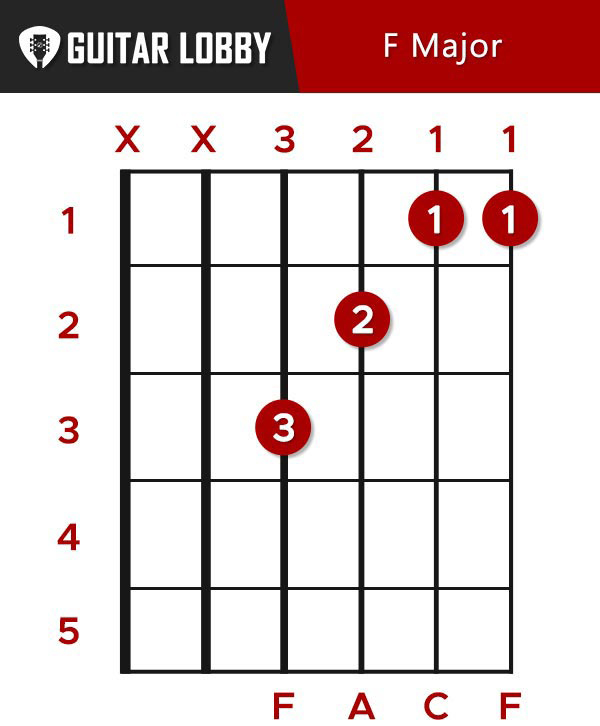
This shape is widely considered the basic F major chord. There are several similar variations, but this is one of the most common and is an alteration of a barre chord where the low E and A strings are left muted making it a bit easier to play than the classic Barre chord shape. The fingering is the following:
- Barre your first finger (index) on the 1st fret of the B and high E strings.
- Place your second finger (middle) on the 2nd fret of the G string.
- Place your third finger (ring) on the 3rd fret of the D string
- Stum the 4 bottom strings, keeping the A and low E strings muted.
Imagine this chord as a mini barred chord, since you only barre the 2 bottom strings. Alternatively, you can play only the 3 bottom strings, leaving the D string muted since the F note is repeated twice in the same chord in both the E and D strings. For this particular type of partial barre chord, the hand position can be slightly different than the strict hand position needed to play full barre chords. You can place the inner part of the hand, meaning the inner side of your thumb, rather than the tip, on the guitar neck. This position puts an angle on the fingers and makes it easier to hold the barre for the bottom 2 or 3 Fingers.
2. F Barre Chord – Root Low E String
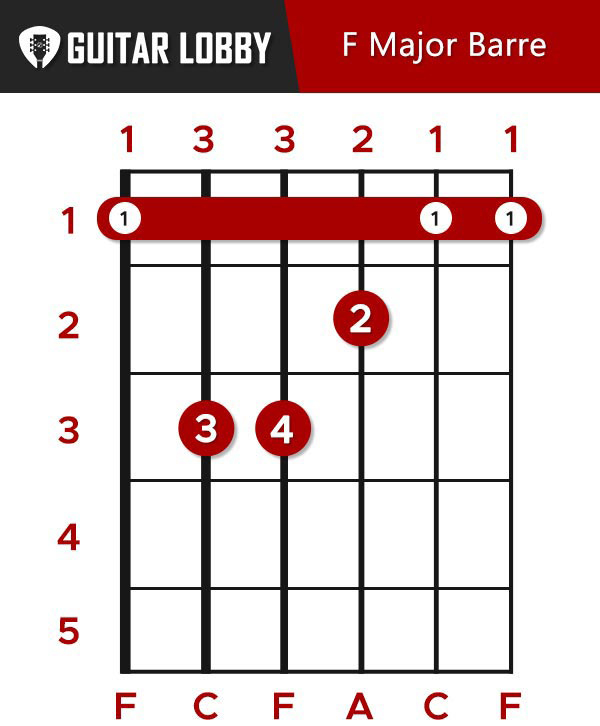
Similar to the first chord above, here we have the full barre chord version of an F major chord. Barre chords can be played in different positions on the fretboard using different fingering depending on the location of the root note. The first position was based with a root on the low E string, the second with the root note on the A string.
The fingering for an F Barre chord with the root note on the low E string is as follows:
- Barre your first finger (index) down on the 1st fret across all 6 strings.
- Place your second finger (middle) on the 2nd fret of the G string.
- Place your third finger (ring) on the 3rd fret of the A string.
- Place your fourth finger (pinky) on the 3rd fret of the D string.
The most used position of the F chord is the classic barred chord at the 1st fret. Supposing that this is your first barre chord, we will give a short insight on how a barre chord is formed and how to play it cleanly. A barre chord is a chord formed when the fingers, usually the index finger, blocks more than 1 string and acts as a guitar capo. The term barre refers to the hand position which acts as a barre to act as if the nut has moved to a new position.
This shape can be a bit more challenging on your hand since the 2 fret gap between the index and middle finger is sometimes a challenge, compressing 3 fingers on the 10th fret can also be a bit tough at first.
Check out this excellent F barre chord exercise:
3. F Barre Chord – Root A String
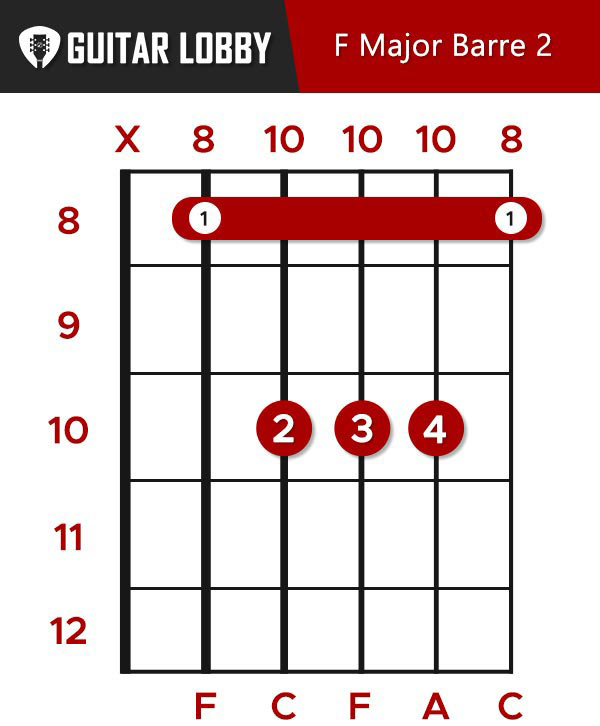
To play the F barre chord apply the following fingering
- Barre your first finger (index) on the 8th fret across the A, D, G, B, and high E strings.
- Place your second finger (middle) on the 10th fret of the D string.
- Place your third finger (ring) on the 10th fret of the G string.
- Place your fourth finger (pinky) on the 10th fret of the B string.
- Keep the low E string muted.
Barre chords require a different approach compared to open chords. The major difference in learning them is that barre chords tend to put some more pressure on the hand, so they often take a bit more practice in order for you to build up the hand dexterity and strength needed to play them properly and effortlessly incorporate them into your playing. If you apply the proper techniques, you can master, barre chords in a couple of short weeks.
4. F Barre Chord – Alternate Fingering
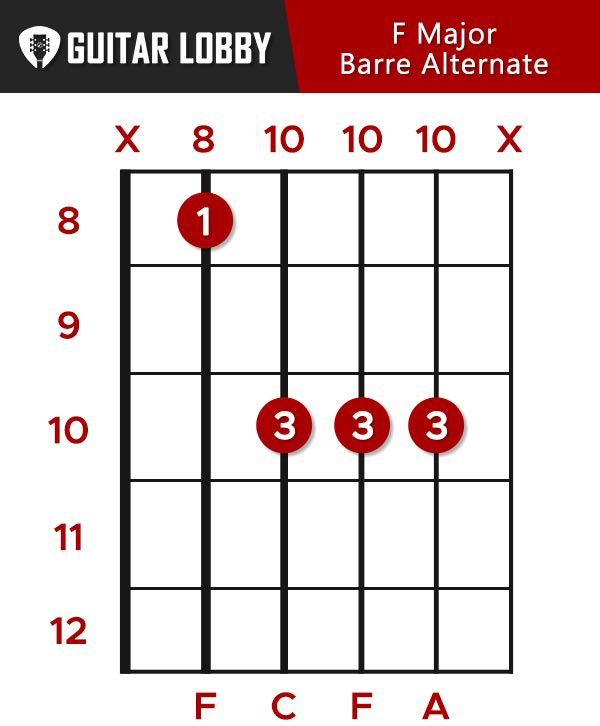
There is another fingering that uses a barre with either your pinky or your ring finger on the 8th fret. Depending on what feels best for you. This fingering can be mastered a bit easier for most players and will sound great also. It’s always ideal to have a number of chord variations in your playing arsenal to help you become a well-rounded and versatile player.
We prepared this video with a more detailed explanation of the chord fingering and general tips on getting barre chords right
(Video Coming Soon)
Tips, Tricks, and Common Challenges
Mastering the F chord means leveling up on your chord game. You can then access all other barre chords positions across the neck.
Some of the most common challenges guitarists face with the F chord are:
- Fret buzzes
- The E or/and B strings are not ringing at all
- I can’t position the barre well enough to cover all the strings
The key to fix most of these issues is focusing on your thumb positioning on the back of the neck as well as the angle your fingers are coming down on the fretboard. Ideally, your fingers are coming straight down on the string as to not lye on top of other strings inadvertently.
Another technique that can help you as a beginner is practicing while holding your guitar in the classical guitar position. This position implies holding the guitar on the left leg (right if you are a leftie) and pointing the guitar neck up. In this position, your left hand is in a more advantageous position.
Expert Insight
Strum slowly and softly when first learning chords. Playing a string with too much strength can alter its pitch and also bring buzzes out of any guitar.
Guitars are not perfect instruments. Sometimes, strumming too hard on a cheap guitar can make frets buzz and bring out some other issues too.
Brief Music Theory
Major chords are formed by the 1st, 3rd, and 5th intervals of the corresponding major scale.
A major scale is formed out of 7 notes, each of them corresponding to a number from 1 to 7. The distance between 2 notes, otherwise called an interval, is also related to these numbers. So for example, the distance between the 1st interval and the 4th interval is a 4th. The distance from the 1st to the 5th is called a 5th and so on.
The notes of the F major scale are:
| F | G | A | B♭ | C | D | E |
| 1 | 2 | 3 | 4 | 5 | 6 | 7 |
Therefore, an F major chord is formed from an F, A, and C note. Chords with 3 notes are also called triads.
If you want to make the chord minor then just lower the 3rd by a half-step. That means move 1 fret down from an A note and play an Ab note.
6. F Major – Variation 2
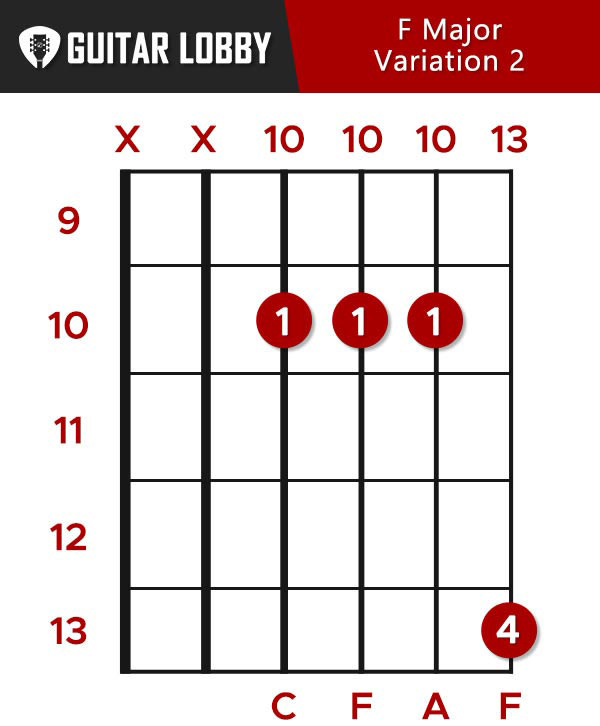
Another cool variation of the F guitar chord is based on the other F barre chord classic shape. The fingering is the following
- Place your first finger (index) as a Barre on the 10th fret of the D, G, and B strings.
- Place your fourth finger (pinky) on the 13th fret of the high E string.
- Play the bottom 4 strings, keeping the low E and A strings mute.
This chord shape adds a high F note to the familiar F barre chord. The F note on the high E gives this note additional treble, making it a great idea to play this shape while jamming with another guitarist or a bass player – it will cut through the mix as your band makes supply the lower notes and you play the high for a rich full mix.
Popular Related Article: Basic Guitar Chords That Are Great for Beginners
7. F Major – Variation 3
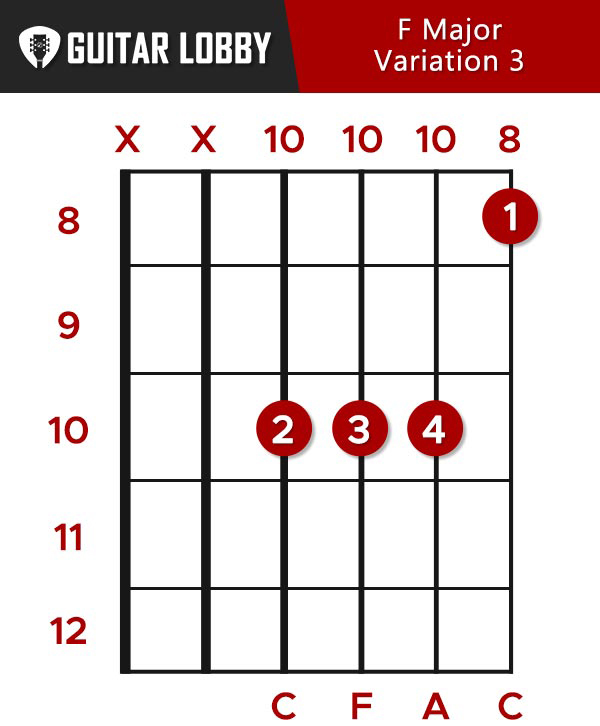
Another variation of the F major chord takes the 3 notes from this barre chord but uses all 4 fingers. The fingering is the following
- Put your second finger (middle) on the 10th fret of the D string.
- Put your third finger (ring) on the 10th fret of the G string.
- Put your fourth finger (pinky) on the 10th fret of the B string.
- Put your first finger (index) on the 8th fret of the high E string.
- Play the bottom 4 strings, keeping the low E and A strings mute.
This chord shape is more challenging than the previous one but still is easier on the hand than the full barre chord shapes.
8. F Major – Variation 4
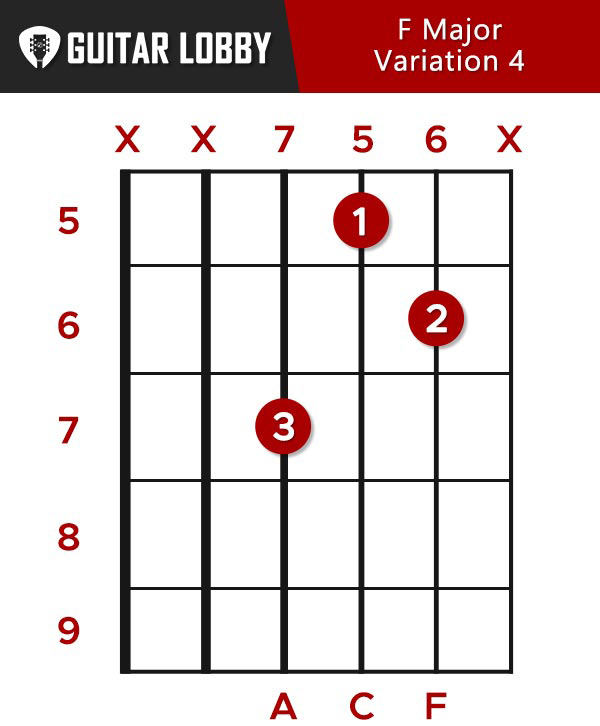
Another way to play the F major chord can be found in the middle area of the fretboard. The fingering for this shape is as follows
- Put your third finger (ring) on the 7th fret of the D string
- Put your first finger (index) on the 5th fret of the G string
- Put your second finger (middle) on the 6th fret of the B string
- Play the 3 fretted strings, keeping the high E, low E, and A strings mute.
This shape is also a triad and part of a group of chords that are called inversions. Inversions use the same 3 notes as triads but switch up the order of notes on the fingering.
On this particular chord the note that stays on top (the top string) in the A note, or the 3rd of the chord.
Careful on not accidentally strumming the high E string. Remember that half step rubs (when you play a note half step lower or higher than the chord root) can sound very rough on the ear.
9. F Major – Variation 5
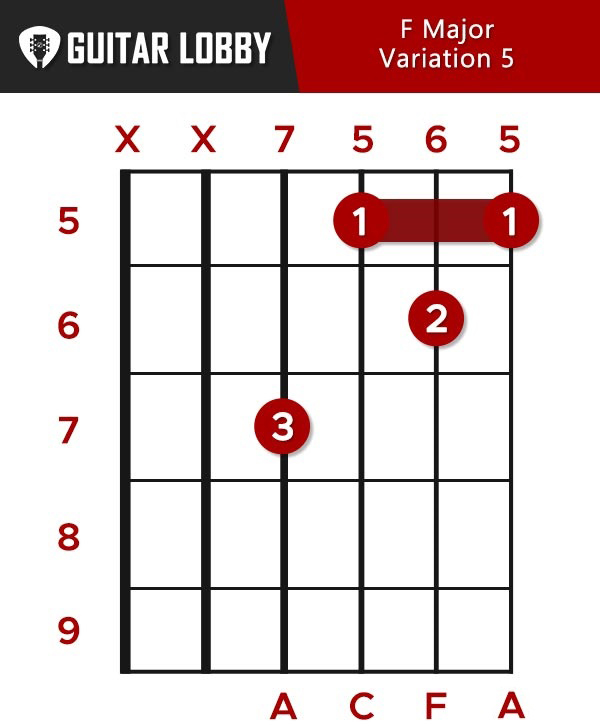
This shape can also be played with a barre on the 5th fret of the G, B, and high E string. The other fingers stay in their original place but you can also add the E string now (since it frets and A note, part of the F major chord) to the chord and strum all 4 bottom strings.
Expert Insight
Knowing which strings to mute, and learning how to do so effectively, is very important when playing chords. Knowing how to not play the wrong notes makes all the difference between a good and bad-sounding chord.
Muting is very difficult to teach and is a skill that naturally develops in guitar players in different forms. As long as you know that a certain string should not ring, apply some basic muting concepts and the rest will develop in time.
10. CAGED F Major Chords
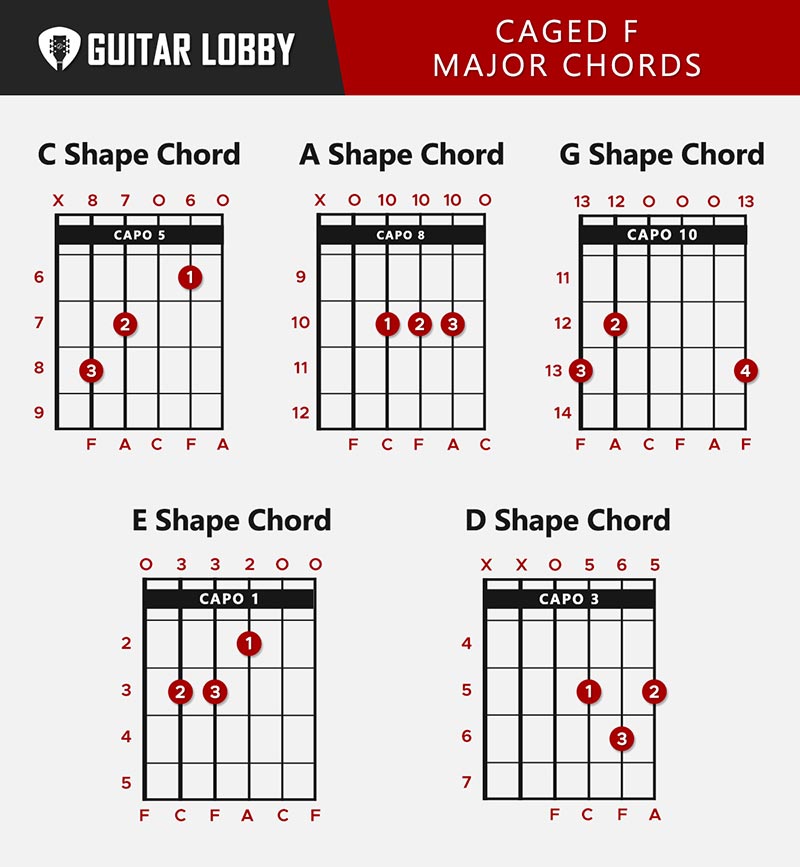
The CAGED system is a very popular way of organizing the fretboard. The system states that all chords can be played in 5 different shapes on the whole fretboard.
The shapes are the open chord shapes of the C, A, G, E, and D chords. Moving these shapes up and down the neck while changing the root note to the chord you are aiming for is the key to this system. So simply put, you can play an F chord in these 5 different shapes, by moving east basic shape to the proper position on the fretboard.
On the chord chart above, you can find all the CAGED chord shapes of the F major chord. As you can notice some of the shapes are the ones we already covered. A good way to understand CAGED chords is to take the first F major barre chord shape as an example.
Play a standard E major open chord first, now move the exact shape you are fingering 1 fret up. Now place the barre on the 1st fret of all six strings and imagine it in the role of the guitar nut. What you get is the F major chord, which is nothing more than an E major shape moved up 1 fret.
Another great F Major CAGED chord is based on the C chord shape. Start by playing a C major open chord. Now if we place a capo on the 5th fret, making that our new nut location, and play the C chord shape on the 6th, 7th, and 8th frets, we have an F major chord.
Check out this video for a more detailed insight into the F major CAGED chords.
(Video Coming Soon)
11. F7 Chord – F Blues Chord
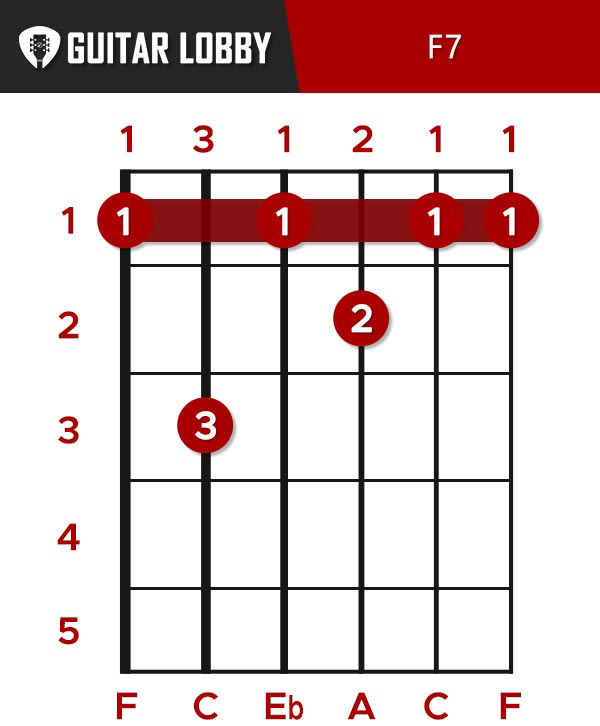
Fundamental to blues guitar are 7th chords. A 7th chord is nothing more than a standard major chord with the added interval. So the formula becomes 1st, 3rd, 5th, and 7th. In the F major scale, the 7th interval is the Eb note. Therefore and F7 is an F Major plus and Eb note.
- Barre your first finger (index) on the 1st fret across all 6 strings.
- Place your second finger (middle) on the 2ns fret of the G string.
- Place your third finger (ring) on the 3rd fret of the A string.
12. F7 – Alternative
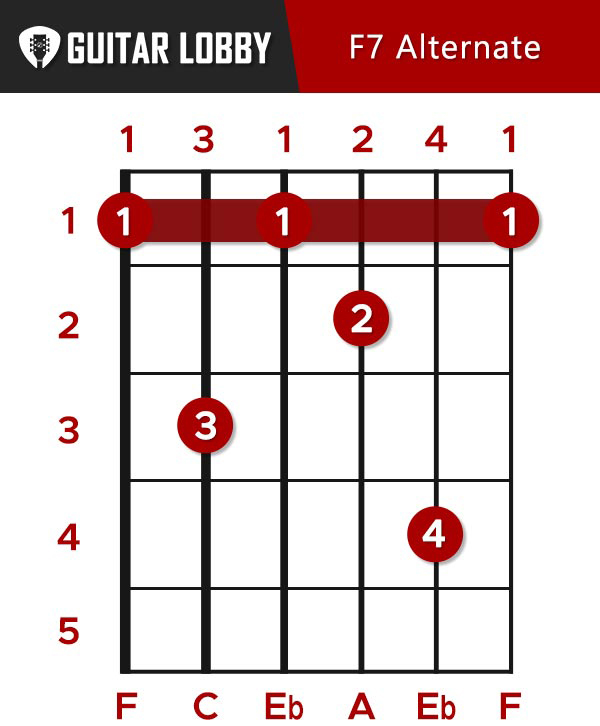
Alternatively, you can also play the chord this way with an extra Eb note. This chord is a bit challenging but add a different dynamic to your playing if you can nail it.
- Barre your first finger (index) on the 1st fret across all 6 strings.
- Place your second finger (middle) on the 2ns fret of the G string.
- Place your third finger (ring) on the 3rd fret of the A string.
- Place your fourth finger (pinky) on the 4th fret of the B string.
More details on these two F7 chord shapes on this video
(Video Coming Soon)
Expert Insight
Try out the 12 bar blues progression when practicing these chords. The F 12 bar blues progression uses the 1st, 4th, and 5th chord of the F Major key. Same numbers and notes that correspond to the notes in the F scale: F, Bb, and C.
To play the 12 bar blues in F you should only play the F7, Bb7, and C7 chords. If you don’t know how to play the other chords you can learn them on our site.
13. F Power Chord – Root Low E String
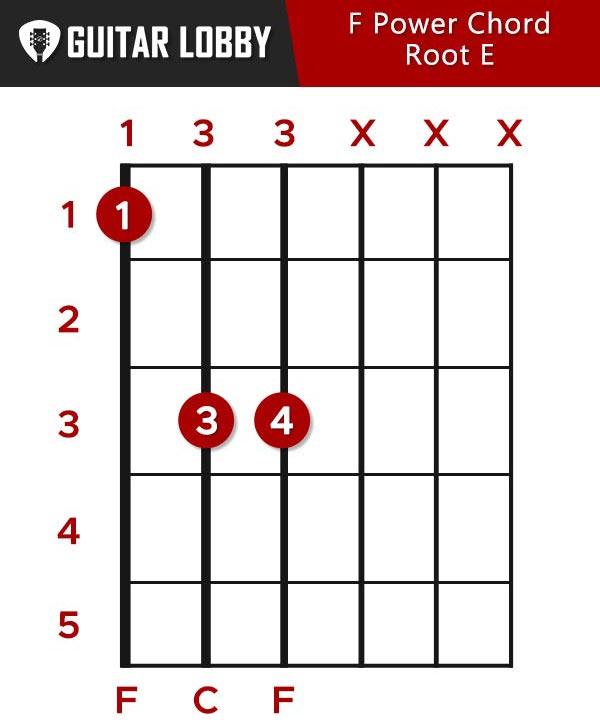
The fingering for the F power chord is the following
- Place your first finger (index) on the 1st fret of the low E string.
- Place your third finger (ring) on the 3rd fret of the A string.
- Place your fourth finger (pinky) on the 3rd fret of the D string.
14. F Power Chord – Root A String
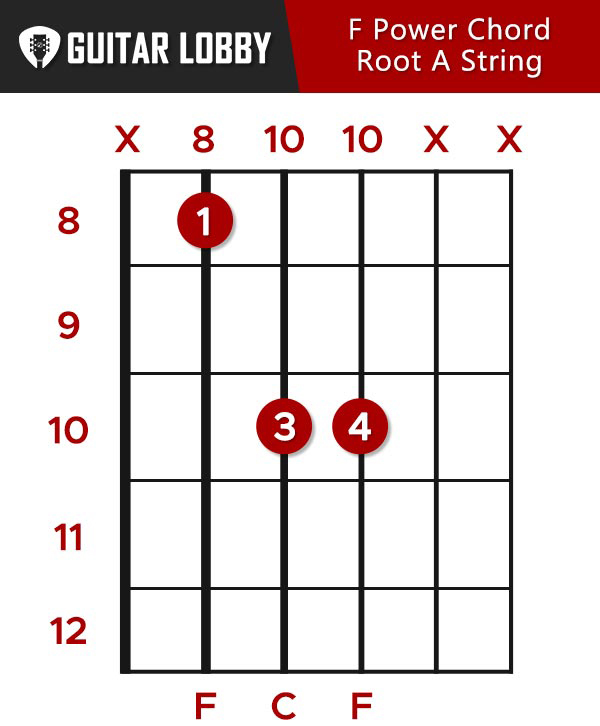
An alternate way of playing the F power chords is to base it on the other shape of the F barre chord.
- Place your first finger (index) on the 8th fret of the A string.
- Place your third finger (ring) on the 10th fret of the D string.
- Place your fourth finger (pinky) on the 10th fret of the G string.
Power chords are made up of only the 1st and 5th intervals. Since there is not the 3rd interval, the chord is neither minor nor major. That means you can safely use it in both situations.
Playing F Chord on Electric Guitar
The electric guitar often requires a bit of a different approach for the F major chord to sound ideal. Keep in mind that the classic acoustic guitar cowboy chord (another name for open chords) in most cases sounds too muddy or chaotic on electric guitar, even with a clean tone in many situations.
When playing with a clean tone on an electric guitar, try to approach strumming in a more gentle, or more detailed manner. Combine right-hand dynamic (playing hard and soft) with arpeggios and strumming of only part of the chord.
Another great tip is to avoid playing the bass notes when you are playing with a bass player in a band. You can try out some of the F guitar chord variations demonstrated in the previous section that avoid the notes on the E and A strings.
Power chords, or otherwise called 5th chords, are widely used in rock and metal music. There are few sounds in all of music more iconic than a distorted power chord. From rock n’ roll to classic rock and metal, power chords have defined the sound of the genres and many sub-genres.
To grasp the concept of power chords quickly, think of them as the upper part of your barre chord and only use the Low E, A, D, and sometimes G chord.
Final Tips on Playing the E Major chord
Use a metronome. Try to place it on a slow count, about 70bpm, and play the F major downstroke once per click. Then start slowly adding upstrokes in between the click and continue practicing being on time with the beat. It might be a bit challenging at first but the payoff is huge for both rhythm and lead playing.
Left-hand muting. While holding the F barre chord on the 8th fret of the A string there is a way to mute the low E string from ringing. Touch it slightly with the tip of your index finger that is playing a note on the A string. That assures the string doesn’t ring if you happen to strum it with your right hand. You can apply the same concept to all the strings and chord shapes that need muting.
Try the 1-minute changes exercise. Set a timer to 60 seconds and choose 3 or 4 chords. Now, at whatever tempo you are comfortable with, play the chords in a rhythm while focusing on playing clean chords with smooth changes. Do this for at least 1 minute at a time. Repeat this process and do this every day for 30 days and track your progress.
If you found this article helpful, be sure to check out our other articles for other major chords A Chord Guitar, B Chord Guitar, C Chord Guitar, D Chord Guitar, E Chord Guitar, and G Chord.

My name is Chris and I’ve had a passion for music and guitars for as long as I can remember. I started this website with some of my friends who are musicians, music teachers, gear heads, and music enthusiasts so we could provide high-quality guitar and music-related content.
I’ve been playing guitar since I was 13 years old and am an avid collector. Amps, pedals, guitars, bass, drums, microphones, studio, and recording gear, I love it all.
I was born and raised in Western Pennsylvania. My background is in Electrical Engineering, earning a Bachelor’s degree from Youngstown State University. With my engineering experience, I’ve developed as a designer of guitar amplifiers and effects. A true passion of mine, I’ve designed, built, and repaired a wide range of guitar amps and electronics. Here at the Guitar Lobby, our aim is to share our passion for Music and gear with the rest of the music community.

Wanting to learn Save Tonight by Eagle Eye Cherry. I’m thinking the first one F major is my best bet as im playing the C major that is a similar shape and I think I can get used to just shifting my fingers up for the chord change.